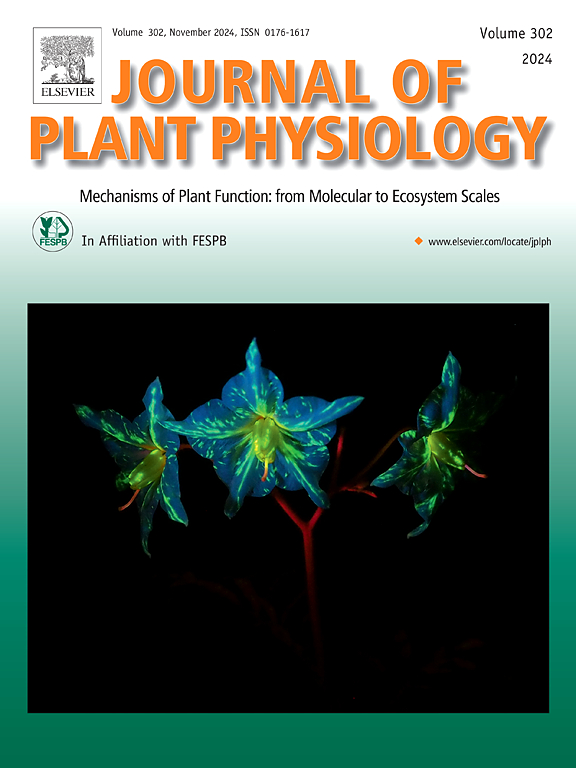GmAIR12-5调控与磷有效性相关的大豆根瘤发育
IF 4.1
3区 生物学
Q1 PLANT SCIENCES
引用次数: 0
摘要
低磷(P)生物利用度限制了豆科根瘤的氮(N)固定。虽然生长素诱导的根12 (AIR12)对植物抗逆性有一定的作用,但其在调节根瘤对缺磷的适应中的作用尚不清楚。本研究通过水培试验发现,缺磷限制了大豆(Glycine max)的生长,降低了根瘤的发育,尤其是大根瘤(直径≥2mm)。通过分析系统发育关系和表达模式,我们发现GmAIR12-5可能在结节中高表达,并与结节的发展有关。GmAIR12-5过表达导致大豆植株生长和氮磷获取显著增加,特别是在低磷条件下。相反,抑制GmAIR12-5降低了大豆的植株生长和养分吸收。低磷水平下,过表达GmAIR12-5可使大结节的数量和重量分别增加67.7%和67.4%,抑制GmAIR12-5可抑制结节的发育。相比之下,在高磷条件下,GmAIR12-5突变体仅在根构型和根瘤重方面表现出显著变化,而茎部生物量和根瘤数与野生型相当。此外,在低P条件下,过表达GmAIR12-5显著下调超氧阴离子含量,增加感染细胞数量。这些结果表明,GmAIR12-5通过避免活性氧积累来促进结核的发展。这一发现增强了我们对AIR12在豆科作物中的作用的认识。本文章由计算机程序翻译,如有差异,请以英文原文为准。
GmAIR12-5 governs soybean nodule development associated with phosphorus availability
Low phosphorus (P) bioavailability limits nitrogen (N) fixation in legume nodules. Although auxin-induced root 12 (AIR12) contributes to plant stress resistance, its role in regulating nodule adaptation to P deficiency remains elusive. In this study, a hydroponic experiment revealed that P deficiency restricted soybean (Glycine max) growth and decreased nodule development, especially in big nodules (diameter≥2 mm). Following analyzing the phylogenetic relationship and expression pattern, we identified that GmAIR12-5 might be highly expressed in nodules and associated with nodule development. Overexpression of GmAIR12-5 led to significant increases in plant growth and acquisition of N and P in soybean, particularly under low-P conditions. Conversely, suppression of GmAIR12-5 reduced the plant growth and nutrients absorption of soybean. Significantly, under low-P levels, overexpression of GmAIR12-5 increased the number and weight of big nodules by 67.7 % and 67.4 %, respectively, while nodule development was inhibited by GmAIR12-5 suppression. In contrast, under high-P conditions, GmAIR12-5 mutants only exhibited significant alterations in root architecture and nodule weight, while maintaining comparable shoot biomass and nodule number to wild type. Furthermore, the overexpression of GmAIR12-5 significantly down-regulated the superoxide anion content and enhanced the number of infected cells under low P conditions. These results demonstrate that GmAIR12-5 contributes to nodule development by avoiding reactive oxygen species accumulation. This finding enhances our understanding of the role of AIR12 in legume crops.
求助全文
通过发布文献求助,成功后即可免费获取论文全文。
去求助
来源期刊

Journal of plant physiology
生物-植物科学
CiteScore
7.20
自引率
4.70%
发文量
196
审稿时长
32 days
期刊介绍:
The Journal of Plant Physiology is a broad-spectrum journal that welcomes high-quality submissions in all major areas of plant physiology, including plant biochemistry, functional biotechnology, computational and synthetic plant biology, growth and development, photosynthesis and respiration, transport and translocation, plant-microbe interactions, biotic and abiotic stress. Studies are welcome at all levels of integration ranging from molecules and cells to organisms and their environments and are expected to use state-of-the-art methodologies. Pure gene expression studies are not within the focus of our journal. To be considered for publication, papers must significantly contribute to the mechanistic understanding of physiological processes, and not be merely descriptive, or confirmatory of previous results. We encourage the submission of papers that explore the physiology of non-model as well as accepted model species and those that bridge basic and applied research. For instance, studies on agricultural plants that show new physiological mechanisms to improve agricultural efficiency are welcome. Studies performed under uncontrolled situations (e.g. field conditions) not providing mechanistic insight will not be considered for publication.
The Journal of Plant Physiology publishes several types of articles: Original Research Articles, Reviews, Perspectives Articles, and Short Communications. Reviews and Perspectives will be solicited by the Editors; unsolicited reviews are also welcome but only from authors with a strong track record in the field of the review. Original research papers comprise the majority of published contributions.
 求助内容:
求助内容: 应助结果提醒方式:
应助结果提醒方式:


